




By Logistics Specialist 1st Class Dustin Hayes Fleet Logistics Center Sigonella - Site Rota
In the heart of Puerto Real, Spain, APERFOSA Women's Shelter is an establishment supporting women and their children who are victims of sex trafficking, abuse, and forced marriage. This sanctuary provides refuge and the vital resources and support needed to help these women and children rebuild their lives. Recognizing the profound impact of this organization, a group of 23 Sailors and civilians from NAVSUP
Fleet Logistics Center Sigonella (FLCSI) - Site Rota stepped forward on April 17 to offer their support. These individuals dedicated their time and energy to revitalizing the shelter's facilities. They tackled a variety of maintenance tasks, including painting, gardening, cleaning, laying down fresh grass, and more. Their efforts represent a tangible demonstration of community engagement and a commitment to enriching their surroundings wherever they go.


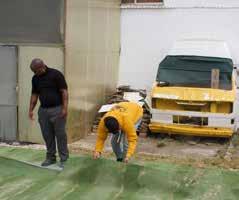







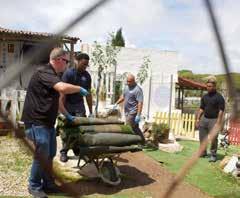







By Ensign Susanna Gaither USS Arleigh Burke Public Affairs Officer
On April 19, 2025, Officers and crew of USS Arleigh Burke (DDG51) coordinated with U.S. Naval Hospital Rota for a cleanup of Admiral’s Beach, on Naval Station Rota. The cleanup contributed to maintaining the natural beauty of the beach for the Naval Station Rota community, and strengthened cooperation between base tenant commands.
“I am immensely grateful to have had this opportunity to build partnerships with other on-base entities and the base as a whole,” said Operations Specialist First Class Marcel Nesmith, who coordinated the cleanup along with US Navy Chaplain Lt. Adewale Giwa-Alaka. “As guests of
Spain, it was great to be able to give back to our host nation.”
For Cmdr. Ethan Reber, Commanding Officer of the Arleigh Burke, the beach cleanup is part of a bigger picture of keeping the ship fully integrated with the Rota community. “We are continuously looking for opportunities to give back to the wider base and Rota community,” said Cmdr. Reber. “From partnership events with our sister ship, ESPS Santa Maria, to community outreach with our tenant command peers, Team 51 strives for excellence afloat and ashore.”
The Arleigh Burke is currently in port Rota, Spain preparing for her sixth Forward Deployed Patrol.

The Arleigh-Burke class guided-missile destroyer USS Roosevelt (DDG 80) returns to Naval Station (NAVSTA) Rota, Spain, following a routine deployment, April 29, 2025.
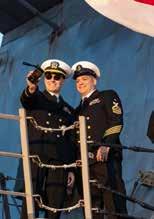






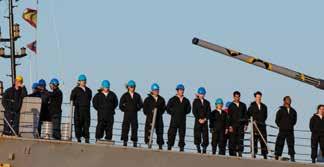









El Chorillo Promenade and the Playa de El Rompidillo
Playa de El Rompidillo in Rota is a beautiful golden beach of fine sand with calm, protected seas. The Chorillo promenade runs alongside it and has a wide variety of tapas bars and restaurants. This is the best beach in Rota to practice water wind sports such as windsurfing, kitesurfing or sailing. In 2016 this town beach was awarded a Blue Flag and the “Q” of Tourism Quality.
Restaurante La Palma is an authentic Neapolitan pizzeria and overlooks the Bay of Cadiz and the Playa de El Rompidillo. The restaurant is conveniently located in front of the El Chorrillo promenade. They offer an authentic Neapolitan pizza made with quality ingredients, most of which are imported from Italy, as well as traditional Italian pasta dishes, grilled meats and fish. The atmosphere is pleasant and family oriented. The restaurant has received numerous positive reviews with Google.
The owner, an authentic Neapolitan, with great experience for more than 35 years as a pizzaiolo, aims to make Neapolitan gastronomy known in town. Authentic Italian beers and wines are available to accompany their dishes, as well as tasty Neapolitan desserts. They have home delivery through Uber Eats or directly with the restaurant at determined times. Events or celebrations, talked about in advance, are welcome here with a special agreed upon menu possible.
The restaurant won the Pizzeria Di Qualita 2024 award from UPIM, an international Pizza association. Please see their ad in the paper for more information.





By Devin Evans Naval Hospital Rotam, Health Promotions Department

More and more Americans have become highly sedentary. 40% of working Americans report that they have a sedentary job and do not engage in any leisure-time physical activity. It is vital to our health to practice regular physical activity, but how much exactly?
Before trying to answer how much physical activity is enough, we need to understand what physical fitness is. Fitness is synonymous with health and our physical condition. Physical fitness is a major factor in influencing our ability to complete tasks that are required for our
vocation as well as meeting our health objectives.
Those serving our country have physical requirements that are measured and tested throughout the entirety of their career. Service members are highly encouraged to partake in daily physical training to support optimal physical fitness and wellness.
Our modernized society has greatly reduced tasks and activities that were once required for survival which has negatively impacted our health and physical condition. Ultimately, for most people who do not have a vocation that requires daily movement and expenditure of energy through physical tasks, putting in extra work is required.
So, back to our original question: How much physical activity do I need to be physically fit? Guideline recommendations are at least 150 minutes of moderate intensity exercise or 75 minutes of vigorous intensity exercise per week. The recommendation for resistance training is 2 or more days per week with exercises that incorporate all major muscle groups.
It is important to recognize that the phrase “at least” is the minimal recommendation for baseline fitness, with more benefits being realized by incorporating longer and more vigorous physical activity. It is important to identify your physical capability at the start before beginning your chosen activity level. If you are someone who has a history of being

sedentary, starting at a lower duration of minutes and gradually increasing that amount as you become more physically fit is a safe and realistic approach.
After doing the math, participating in 30 minutes of moderate physical activity daily over a 5-day period will meet the introductory physical activity recommendation. Remember that recommendations can be met in many ways, such as breaking the daily 30 minutes into 3 ten-minute sessions, or any other way that works realistically with your schedule and time availability.
Lastly, don’t discount the importance of non-exercise activities such as proper posture standing, walking during your day, using stairs, and moving from sitting to standing positions. These unstructured
physical activities can help you meet your physical fitness goals by being more active rather than sedentary which will improve your overall health and wellness.
Explore and discover what physical activity works for you and brings you enjoyment. Remember, physical fitness is a lifelong venture that should be fun!










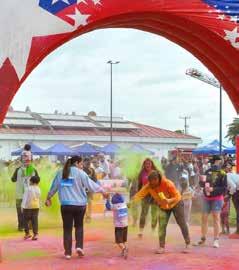





By Lt. Daniel Ehrlich Naval Station Rota, Spain Public Affairs
The U.S. Office of Defense Cooperation (ODC) Spain hosted the annual Bilateral Training and Exercise Conference (BTEC) alongside the Spanish military joint staff, Estado Mayor de la Defensa, at El Centro Superior de Estudios de la Defensa Nacional (CESEDEN), April 8-9, 2025. BTEC 2025 brought together more than 80 military professionals from the United States Navy, Army, Air Force, and Marine Corps and Spanish Army, Navy, Air Force, Marine Corps, and Military Emergencies Unit (UME) to work side-byside in planning combined training events for the upcoming year, which increases interoperability between the two allies.
“The purpose of BTEC is to get approval from the Spanish Joint Staff to conduct bilateral engagements in Spain,” said U.S. Marine Corps Col. Romeo Cubas, U.S. Spain Permanent Committee operations officer and chief organizer for the U.S. contingent at BTEC 2025. “It expedites the execution of the events with the individual components and their Spanish counterparts.”
U.S. Navy Capt. Karsten Spies, chief of ODC Spain, and Spanish Marine Corps Col. Jose Ignacio Yaniz Lopez officially commenced BTEC 2025 by welcoming participants and with opening remarks. From there, attendees split into working groups, known as syndicates, that focused on a specific operational component, including air, land, maritime, special operations, and support (emergency, medical, and cyber).
This year’s conference yielded 114 combined training and exercise events scheduled for 2026 with 16 of those being
newly proposed this year. The trainings proposed during the conference are finalized at the end of the conference during a plenary session and subsequently forwarded to the Spanish Ministry of Defense for approval to execute them.
“Combined training plays a crucial role in increasing the readiness and deterrence power of U.S. forces in Spain and elements of those stationed elsewhere in Europe and enhances interoperability with our Spanish allies,” said Spies.
BTEC is an opportunity for military units from both nations to compare training calendars and find overlap. Often, the overlap provides a chance for these units to combine their training events, which can serve the purpose of both increasing interoperability for U.S. units operating in Spain to work alongside their hosts to solve problems together and to fulfill U.S. theater strategic plans to maximize readiness and preparedness for any conflict.
“Our training tends to focus at the unit-level, so here we are able to build partnerships at the small unit-level with our counterparts,” said U.S. Marine Corps Maj. Michael Guzman, company commander for Fleet Anti-terrorism Security Team Company, Europe, who sat in on the land syndicate. “BTEC allows us to build good relationships with our partners and allows me to keep my Marines ready and trained for all their future missions.”
The conference didn’t just include military representatives from operational units, but also representatives from the U.S. installations hosted on several Spanish bases. The U.S. Navy has five ships homeported out of Naval Station


Rota, which is a U.S. installation hosted by the Spanish Armada at Rota Naval Base. The installation also has 45 other commands present from four U.S. military branches that fulfill a variety of operational missions. In addition, U.S. forces are hosted at Morón Air Base, Torrejon Air Base, and Military Base Betera. With such a significant forward-deployed capability, personnel representing these installations, including U.S. Navy Cmdr. Henry Morgan, operations officer for U.S. Naval Station Rota, emphasized the coordination of U.S. assets at these installations with their Spanish hosts.
“The big events we’ve been talking about involve our forward-deployed naval force ships and giving them opportunities to train alongside the Spanish,” said Morgan. “Making sure the Spanish know what to expect and the fleet assets know what they have available to them is important to keep mutually moving forward.”
While much of the discussion revolved around training and exercises to improve interoperability and the capabilities of the two forces, it also focused on setting up opportunities to practice and prepare for emergencies and disasters. One of the key emergency management and response components of the Spanish armed forces present at BTEC, UME, led the charge in discussing key emergency preparation exercises.
“We will work together, which will involve greater understanding of our militaries, our capabilities,” said Capt. Sergio Nunez, an officer with the contingent representing UME at BTEC 2025. “And, of course, greater understanding of training to respond to whatever the future may hold.”
For decades, BTEC has been an
annual staple in the U.S.-Spain military relationship. This year’s BTEC 2025 venue, CESEDEN, was an example of the amount of planning and the value of this annual meeting between both the allies’ military contingents.
“The planning process takes almost a year,” said Spanish Army Comandante Francisco Teijido Lopez, chief organizer for the Spanish contingent at BTEC 2025. “This year, the event was held at a historic building in Madrid whose facilities host the most important joint courses of the Spanish armed forces.
The U.S.-Spain relationship dates back much further than the arrival of U.S. forces in 1953, and BTEC is just a small example of the extended partnership between the two allies. Throughout BTEC, participants talked, laughed, and socialized through the halls of CESEDEN, passing portraits highlighting shared moments of SpanishAmerican military partnership.
“Long before we became treaty allies, Spain was one of our oldest military partners, helping us gain our independence in the Revolutionary War so that we can now celebrate our 250th birthday as a Navy and as a nation,” said Spies, “We are honored to continue building readiness and operating together with the Spanish forces.”
The Spain-U.S. Bilateral Training and Exercise Conference (BTEC) is a co-hosted, collaborative meeting between units from the U.S. Department of Defense (DOD) and the Spanish Ministry of Defense (MoD) with the chief goal of building joint force interoperability and readiness, while fostering the longenduring defense partnership between Spain and the United States.
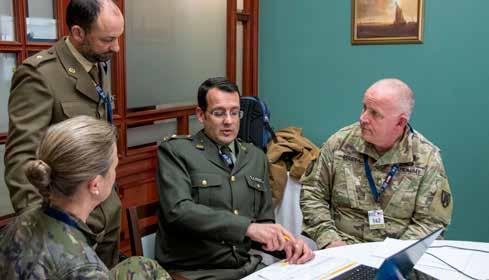


U.S. Navy Yeoman 2nd Class Trevor Wilson, from Ft. Lauderdale, Fla., is the lead Command Pay and Personnel Administrator (CPPA) for Navy Supply Systems Command (NAVSUP) Fleet Logistics Center (FLCSI) Site Rota.
"I manage, track, and draft all routine correspondence and all pay related matters for sailors at the NAVSUP FLCSI enterprise," said Wilson. "Taking care of sailors is my #1 priority!"
Wilson stated what he enjoys most about his job is the ability to network with Sailors and provide administrative support to them and their families. Aside from his primary job, Wilson also has collateral duties which include being the Assistant Command Fitness Leader (ACFL) and the Treasurer for NAVSTA Rota's Second
Class Petty Officer Association. On his free time from work, Wilson mentioned some of his hobbies consist of reading, bike riding, traveling, and trying new recipes.
Prior to arriving to Naval Station (NAVSTA) Rota, Spain, Wilson was assigned to the USS Ronald Reagan (CVN 76) from November 2019 to December 2023. While many people enjoy living in Spain, Wilson stated that his favorite thing about being stationed in this beautiful country is the ability to travel to different regions of Spain and learn about the Spanish culture and history. "I like traveling! Please feel free to recommend some of your favorite countries!"






















· Used vehicle sales
· We manage all the documentation for Acces to the Base and be legal on spanish road



















Company dedicated to the purchase and sale of used vehicles for the American population of Rota Navy Base and Moron Air Base
· We will buy cars from people transfering out of Spain
· More then 20 years selling and buying cars

American Dama, Olivia Bussey, Participates in Rota Feria 2025 Opening Ceremony













By Ashley Leigh Contributing Community Writer
We come across many different people during our various changes of duty station, some of whom we like and others we would rather avoid. One thing that is a common thread amongst our spouse society is how we self-indulge our inner feelings to complete strangers. Call it a nervous energy or just wanting to make a friend, literally any friend, we do it. You’re out walking your dog when you come across another person walking their dog. You do the awkward dance of “So, is their dog friendly?” and “My dog wants to play with their dog, but is it alright with them or not?” dance. You take your headphones out and say something to the effect of “My dog is friendly, is yours friendly?” That’s when the magic happens.
You introduce yourself to a total stranger. Then the usual questionnaire happens:
“What does your spouse do?”
“Where was your last base?”
“Do you have kids?”
Yada yada.
At some point, the conversation turns into a therapy session. One spouse spews out all their thoughts and feelings about their life, what’s going on with their kids, household goods, and even relationship issues. Sometimes you don’t mind the conversation, but other times you’re just trying to let your dog make a friend, not be a personal counselor.
I’ve been in physical therapy (PT) for over a year now. Over that time, I’ve become pretty invested in the lives of the therapist. From relationship issues, grammar on paperwork, flying pets into Spain, security questions and so much
more. The time I spend in my physical therapy sessions end up turning into personal therapy sessions. For example, one physical therapist, who we’ll call “TX,” and I have had many PT sessions together, during which we’ve talked about relationships with the opposite gender, why Texas may or may not be considered a southern state, and making rash purchases. Another physical therapist, who we’ll call “D Cubed,” and I talk about our dogs. (As a side note, the physical therapists asked if they could be included in an article.)
The encounters we have are all pieces to the puzzle of our time as spouses. Every duty station we arrive at gives us another opportunity to help and be kind to those we live and work with. Sometimes it’s hard for us to not push our opinions onto others. I’ve known people who like to just tell everyone what is wrong with this or that, or how to live their lives. Let’s be real,

those people are annoying. Most likely, it seems that we all just want someone to listen to us. Another person who has been through what we have is ideal when asking for advice or help. There is a sense of compassion to want to help others who are in our same type of military boat. Let’s be kind and listen. Author Roy T. Bennet once quoted, “Sometimes all a person wants is an empathetic ear; All he or she needs is to talk it out.”
Naval Station Rota hosted Exercise MAGRE 25-1 with Explosive Ordnance Disposal (EOD) Mobile Unit 8 (EODMU8) detachment Europe and Spanish Armada underwater mine countermeasure units from Cadiz and Cartagena, March 2428, 2025.
Exercise MAGRE is a semi-annual bilateral counter improvised explosive device (IED) exercise consisting of unexploded ordnance disposal procedures, weapons drills and explosive device drills.
“Sharing of tactics, techniques and procedures and helping each other out with improving our skills as EOD technicians is the primary goal of these exercises,” said Lt. j.g. Jonathan Chapman, officer in charge, EODMU 8 det. Europe. “It ensures that all of our units are a lethal force when we go down range and that we’re ready to take care of any kind of IEDs or surface ordnance responses.“
The exercise is designed to increase interoperability and interchangeability between naval mine warfare and mine countermeasure forces between U.S. and NATO Allies and partner forces in the region.
“The realization of this type of bilateral
exercise between the United States and Spain is very beneficial because it offers us the opportunity to learn lessons from the personnel of our United States colleagues in their combat zone of operations,” said 2nd Lt. José Luis Sánchez Caucín, assigned to La Unión in Cádiz. “It is a continuous learning process to always maintain the high level of readiness required.”
Commander, Task Group 68.1 (EODMU 8) is part of the forward deployed Navy Expeditionary Combat Force EuropeAfrica/Commander, Task Force (CTF) 68. CTF 68 is responsible for providing explosive ordnance disposal operations, naval construction, expeditionary security and theater security efforts to U.S. Naval Forces Europe (NAVEUR)-U.S. Naval Forces Africa (NAVAF) and U.S. 6th Fleet.
For over 80 years, NAVEUR-NAVAF has forged strategic relationships with allies and partners, leveraging a foundation of shared values to preserve security and stability.
Headquartered in Naples, Italy, NAVEUR-NAVAF operates U.S. naval forces in the U.S. European Command (USEUCOM) and U.S. Africa Command (USAFRICOM) areas of responsibility.







By Pilar Ruiz
Taste of Cádiz in Every Bite

Have any comments or questions? We'd love to hear from you! You can email us as pilaraprendiendoacocinar@gmail.com.
This time, we’re bringing you a hearty, flavorful, and healthy stew that’s perfect for the season: Marmitako, a traditional Spanish tuna stew.
Right now, we’re in the tuna season in the bay of Cádiz, where the waters of Barbate, Zahara de los Atunes, and Tarifa are known for their almadraba tuna fishing, a practice that has been passed down through generations. Now is the perfect time to enjoy the freshest tuna and make the most of this incredible local delicacy!
Originating from the Basque Country and Cantabria, Marmitako is a traditional fisherman's dish, often made with potatoes, onions, peppers, tomatoes, and, of course, tuna. In Spain, tuna is one of the most consumed blue fish, and we’re sure you’ll find this dish simple to prepare and full of local flavors.
INGREDIENTS:
• 1 1/8 lbs (1/2 kg) tuna loin, cut into cubes
• 2 1/4 lbs (1 kg) potatoes
• 1 onion, finely diced
• 2 cloves of garlic, chopped
• 1 green pepper, chopped

• 2 grated tomatoes or 4 tablespoons of crushed tomato
• 2 dried red peppers (ñoras, if possible), chopped
• 2 "Piquillo" sweet peppers, chopped
• 1 tablespoon sweet paprika
• 1/2 cup (100 ml) mild olive oil
• 1/2 cup (100 ml) white wine, we use local sherry wine from Bodegas “El Gato”
• A splash of “Brandy of Jerez”
• 2 glasses of water (or enough to cover the stew)
• 1 fish stock bouillon cube
PREPARATION:
1. Begin by peeling and breaking the potatoes into chunks, and then place them in a bowl of water (breaking them is easy – just insert a knife slightly into the potato and twist the blade to break off small pieces).
2. In a large pot with hot olive oil, sauté the diced onion (brunoise style). Once it’s softened, add the chopped garlic. When the garlic turns golden brown, stir in the chopped green pepper and “piquillo” peppers.
3. Add the drained potato chunks to the pot and toss them to coat in the flavorful vegetable mixture.
4. Stir in the grated tomato and sweet paprika, mixing everything well.
5. Pour in the white wine and splash of cognac. Let it cook for a few minutes until the alcohol evaporates.
6. Add enough water to just cover the potatoes, and dissolve the fish stock cube in a small amount of warm water before adding it to the pot.
7. Let the stew simmer on low heat for about 1 hour, until the potatoes are tender.
8. Five minutes before the stew is ready, season the tuna chunks with salt and pepper, and gently add them to the pot. Cook for another 5 minutes.

